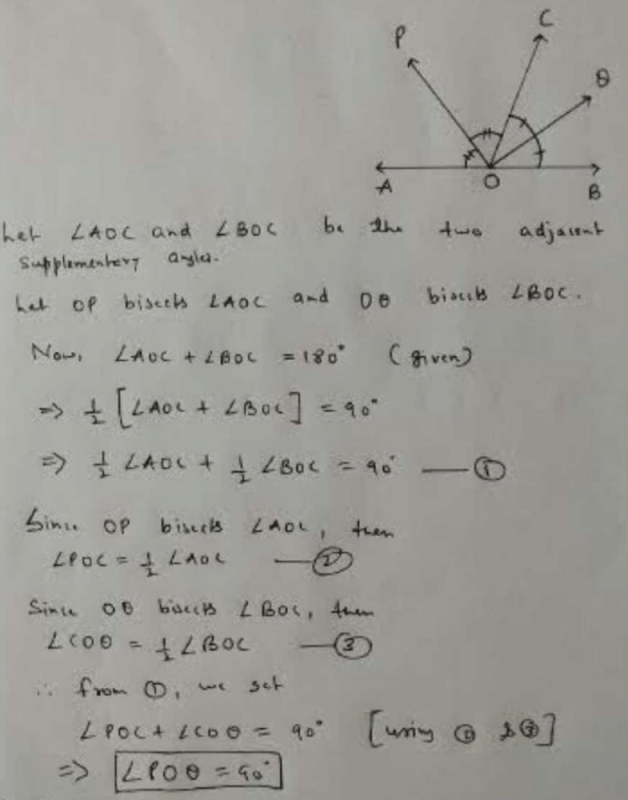Class 9 Exam > Class 9 Questions > Prove that the bisectors of two adjacent supp...
Start Learning for Free
Prove that the bisectors of two adjacent supplementary angles include a right angle.?
Most Upvoted Answer
Prove that the bisectors of two adjacent supplementary angles include ...

Community Answer
Prove that the bisectors of two adjacent supplementary angles include ...
Proof:
To prove that the bisectors of two adjacent supplementary angles include a right angle, let's consider the following scenario:
Given:
- Two adjacent supplementary angles, say angle AOB and angle BOC.
- The bisector of angle AOB is AD.
- The bisector of angle BOC is BE.
We need to prove that angle ADB is a right angle.
Proof:
Step 1:
Draw the line segment OC extending from point O towards C, such that angle AOC is a straight line (180 degrees).
Step 2:
Since angle AOB and angle BOC are adjacent supplementary angles, they add up to 180 degrees.
Step 3:
The bisector of angle AOB, AD, divides angle AOB into two equal halves, creating angle ADB and angle BDA.
Step 4:
Similarly, the bisector of angle BOC, BE, divides angle BOC into two equal halves, creating angle BDE and angle EDC.
Step 5:
Since angle AOB and angle BOC are supplementary, angle AOC is a straight line.
Step 6:
From step 3, we know that angle ADB and angle BDA are equal in measure.
Step 7:
From step 4, we know that angle BDE and angle EDC are equal in measure.
Step 8:
From step 6 and step 7, we can conclude that angle BDA + angle BDE + angle EDC = 180 degrees.
Step 9:
Since angle BDA + angle BDE + angle EDC is equal to the measure of angle AOC (180 degrees), we can conclude that angle BDA + angle BDE + angle EDC = angle AOC.
Step 10:
From step 5 and step 9, we can conclude that angle BDA + angle BDE + angle EDC = 180 degrees = angle AOC.
Step 11:
Since angle ADB and angle BDA are equal in measure (from step 3), and angle BDE and angle EDC are equal in measure (from step 4), we can conclude that angle ADB + angle BDE + angle EDC = 180 degrees.
Step 12:
From step 11, we know that angle ADB + angle BDE + angle EDC = 180 degrees = angle AOC.
Step 13:
From step 12, we can conclude that angle ADB + angle BDE + angle EDC = angle AOC, which implies that angle ADB is equal to angle AOC.
Step 14:
Since angle AOC is a straight line (180 degrees), angle ADB must
Attention Class 9 Students!
To make sure you are not studying endlessly, EduRev has designed Class 9 study material, with Structured Courses, Videos, & Test Series. Plus get personalized analysis, doubt solving and improvement plans to achieve a great score in Class 9.

|
Explore Courses for Class 9 exam
|

|
Similar Class 9 Doubts
Prove that the bisectors of two adjacent supplementary angles include a right angle.?
Question Description
Prove that the bisectors of two adjacent supplementary angles include a right angle.? for Class 9 2024 is part of Class 9 preparation. The Question and answers have been prepared according to the Class 9 exam syllabus. Information about Prove that the bisectors of two adjacent supplementary angles include a right angle.? covers all topics & solutions for Class 9 2024 Exam. Find important definitions, questions, meanings, examples, exercises and tests below for Prove that the bisectors of two adjacent supplementary angles include a right angle.?.
Prove that the bisectors of two adjacent supplementary angles include a right angle.? for Class 9 2024 is part of Class 9 preparation. The Question and answers have been prepared according to the Class 9 exam syllabus. Information about Prove that the bisectors of two adjacent supplementary angles include a right angle.? covers all topics & solutions for Class 9 2024 Exam. Find important definitions, questions, meanings, examples, exercises and tests below for Prove that the bisectors of two adjacent supplementary angles include a right angle.?.
Solutions for Prove that the bisectors of two adjacent supplementary angles include a right angle.? in English & in Hindi are available as part of our courses for Class 9.
Download more important topics, notes, lectures and mock test series for Class 9 Exam by signing up for free.
Here you can find the meaning of Prove that the bisectors of two adjacent supplementary angles include a right angle.? defined & explained in the simplest way possible. Besides giving the explanation of
Prove that the bisectors of two adjacent supplementary angles include a right angle.?, a detailed solution for Prove that the bisectors of two adjacent supplementary angles include a right angle.? has been provided alongside types of Prove that the bisectors of two adjacent supplementary angles include a right angle.? theory, EduRev gives you an
ample number of questions to practice Prove that the bisectors of two adjacent supplementary angles include a right angle.? tests, examples and also practice Class 9 tests.

|
Explore Courses for Class 9 exam
|

|
Suggested Free Tests
Test: The Fundamental Unit of Life- Case Based Type Questions- 1
Test | 10 questions
Signup for Free!
Signup to see your scores go up within 7 days! Learn & Practice with 1000+ FREE Notes, Videos & Tests.

























